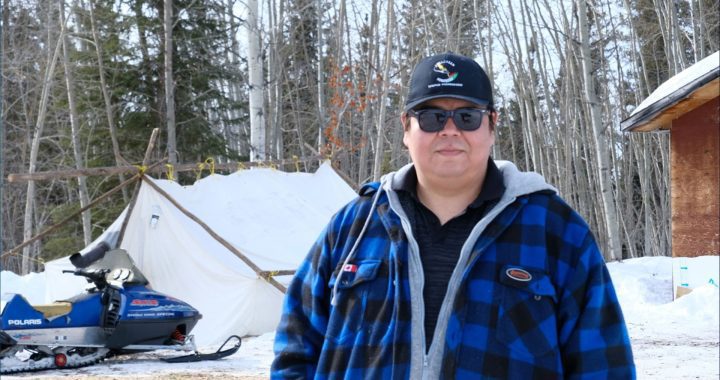(Billy Gauthier says he will not eat until the province addresses flooding that will send toxins downstream to where his people hunt and fish. On Wednesday, two more people joined him on the hunger strike.)
Trina Roache
APTN National News
An Inuk artist in Labrador says the province’s latest response to the controversial Muskrat Falls hydroelectric project isn’t good enough to end his hunger strike.
“You can’t pull the wool over my eyes,” said Billy Gauthier. “We obviously cannot rely on our provincial government to do the right thing for the people of Labrador.”
On Tuesday, day six of Gauthier’s hunger strike, the province announced it will require its energy corporation Nalcor to remove more trees from the reservoir at Muskrat Falls.
But Gauthier, along with Innu and Inuit leaders, have demanded Nalcor fully clear the flood zone.

A 2015 study by Harvard University predicts that trees and topsoil underwater will create methylmercury, a toxin that will flow downstream and contaminate traditional Inuit food sources.
Denise Cole, an Inuk land protector from Labrador, was in St. John’s and attended a news conference Wednesday held by the Natural resources and Environment ministers, to hear the plan firsthand.
“To me, today that was just spin,” said Cole. “Government knows they’re in trouble and public opinion is changing about this project, so this is damage control.”
Cole still has a lot of questions about how large of an area will be cleared, if it will be done before flooding, and whether the topsoil is included in what will be removed.
“It’s very vague,” she said. “And it changes nothing. The cause is very much the same. We need to do whatever measures possible to stop this. And if the government won’t do that, we will.”
Nalcor’s Vice-President of the Lower Churchill project Gilbert Bennett held a technical briefing Tuesday afternoon in St. John’s.
Bennett said Nalcor had only just received the order from the province to clear more trees but didn’t anticipate a significant impact on ongoing operations at the dam.
“We’re going to work on schedule and look at additional clearing,” said Bennett. “The focus of this effort now is to look at areas beyond the 25 metre area.”
Bennett then acknowledged, “We have been asked to assess all aspects of the reservoir.”
Including that 25 metre area which is the first to be flooded. It covers around 11 square kilometres, about a quarter of how big the reservoir will be when it’s fully flooded by 2019. The initial flooding has not yet started, but will by the end of October.
“Basically what he’s saying is, we’ll cut some of the trees down,” said Gauthier. “But we’re still going to poison your people.”
It’s been a frustrating and emotional day for Gauthier, sitting in a tent where land protectors have camped outside of the Muskrat Falls site. The same place nine people were arrested for violating a court injunction in an early morning raid Monday, though no one is blockading access to the site now.
Gauthier isn’t alone in his hunger strike anymore. Delilah Miriam Saunders and Jerry Kohlmeister have joined him.
I would’ve done this regardless,” said Gauthier. “But I can guarantee I wouldn’t be standing quite as tall. None of us are backing down. We are warriors. We’re all warriors.”
People are now fundraising to send Gauthier to Ottawa. He still believes there’s a role for the federal government to play.
Though Labrador MP and Parliamentary Secretary to the Minister of Indigenous Affairs Yvonne Jones asked for a review of the federal permits, that’s not going to happen.
So Gauthier wants to take his hunger strike to Prime Minister.
“Here in the wilds of Labrador, we’re often forgotten about,” he said. “But if we’re standing right there in the front of the Parliament Buildings, continuing our starvation, we will be in their faces.”
President of the NunatuKavut Community Council Todd Russell said the province’s announcement “provides us with very little detail on whether there will be a reduction in methylmercury contamination.”
Russell, who represent the Southern Inuit in Labrador, said he’ll be waiting for more information.
Until then, he said, “Our on-the-ground action continues.”
During Nalcor’s briefing, Bennett did provide some information on what’s being done to mitigate the impacts of methylmercury.
There’s been work on baseline data since 1999 on the Lower Churchill River. The science and models Nalcor Energy is using predicts an increase in methylmercury of between 2.3 and 4.8 times current levels. Mercury is a natural occurring toxin found in fish species.
However, the study by Harvard University predicts that within hours of flooding, there could be a sharp increase ranging from 25 to 200 per cent in certain areas along Lake Melville that will last for decades.
Bennett says Nalcor has a monitoring program in place and plans to work with other regulators, including the provincial health boards and Health Canada, to put out consumption advisories, warning people not to eat certain foods if methylmercury levels are too high.









